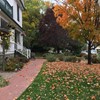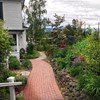







































































Ashland, Oregon, United States of America
Agent: Cliff Jacobs - Managing Principal Estate Agent & CEO (Nat.Dpl.Hotel Man (UJ). M.P.R.E.)
Agent Cellphone: +27 (0) 84 413 1071 / +27 (0) 61 716 6951
Agent Office Number: +27 (0) 84 413 1071
Agent Email Address: cliff@exquisitehotelconsultants.com
Type: Bed and Breakfast
Bedrooms: 6
Bathrooms: 8
Showers: 8
Parking: 8
Yield: Not Disclosed
TGCSA Rating:

Ashland
Ashland is a city in Jackson County, Oregon, United States. It lies along Interstate 5 approximately 16 miles (26 km) north of the California border and near the south end of the Rogue Valley. The city's population was 20,078 at the 2010 census and was estimated to be 21,281 as of 2019.
The city is the home of Southern Oregon University (SOU) and the Oregon Shakespeare Festival (OSF). These are important to Ashland's economy, which also depends on restaurants, galleries, and retail stores that cater to tourists. Lithia Park along Ashland Creek, historic buildings, and a paved intercity bike trail provide additional visitor attractions.
Ashland, originally called "Ashland Mills", was named after Ashland County, Ohio, the original home of founder Abel Helman, and secondarily for Ashland, Kentucky, where other founders had family connections. Ashland has a mayor-council government assisted by citizen committees. Historically, its liberal politics have differed, often sharply, with much of the rest of southwest Oregon.
History
Prior to the arrival of white settlers in the mid-19th century, the Shasta people lived in the valley along Ashland Creek approximately where today's city is located. Early Hudson's Bay Company hunters and trappers following the Siskiyou Trail passed through the site in the 1820s. In the late 1840s, mainly American settlers following the Applegate Trail began passing through the area. By the early 1850s, the Donation Land Claim Act brought many to the Rogue Valley and into conflict with its native people. These often violent clashes, known ultimately as the Rogue River Wars, continued until 1856.
In 1851, gold was discovered at Rich Gulch, a tributary of Jackson Creek, and a tent city grew on its banks, today's Jacksonville. Settlers arrived in the Ashland area in January 1852, including Robert B. Hargadine, Sylvester Pease, Abel D. Helman, Eber Emery, and others. Helman and Hargadine filed the first donation land claims in Ashland. Helman and Emery built a sawmill along what was then called Mill Creek to turn timber into lumber for settlers. In 1854, they and another settler, M. B. Morris, built a second mill, Ashland Flouring Mills, to grind local wheat into flour. The community around the mill became known as "Ashland Mills". A post office was established in Ashland Mills in 1855 with Helman as postmaster.
During the 1860s and 1870s, the community grew, establishing a school, churches, businesses, and a large employer, Ashland Woolen Mills, which produced clothing and blankets from local wool. In 1871, the Post Office dropped "Mills" from Ashland's name. In 1872 Reverend J. H. Skidmore opened a college, Ashland Academy, a predecessor of Southern Oregon University.
In 1887, Portland, Oregon, and San Francisco, California, were joined by rail at Ashland. Until 1926, when most rail services began taking a different route (east through Klamath Falls to avoid the steep grade through the Siskiyou Mountains), Ashland thrived on rail trade of local products, including pears, peaches, and apples.
In 1908 the Women's Civic Improvement Club petitioned for the creation of community space along Ashland Creek, which became Ashland Canyon Park. The discovery of lithia water near Emigrant Lake around the same time led to a plan to establish a mineral spa at the park. Voters approved bonds to pay for the project, which included piping the mineral water from its source to Ashland. The town engaged John McLaren, landscape architect of San Francisco's Golden Gate Park, to design the park, renamed Lithia Springs Park, later shortened to Lithia Park. Although the park was popular, the mineral spa plans proved too expensive for local taxpayers and were abandoned in 1916. Meanwhile, entrepreneurs took to bottling and selling mineral waters from the area's springs.
During the Fourth of July celebration in 1935, Angus L. Bowmer arranged the first performances of what would become the Oregon Shakespeare Festival. The festival grew during the 20th century and has become an award-winning and internationally known regional theater company.
Many of Ashland's historic buildings have been preserved and restored. The city has 48 individual structures and two historic districts (the Ashland Railroad Addition District and the Downtown District) on the National Register of Historic Places. The structures include the Enders Building (home of the Columbia Hotel), which from 1910 to 1928 contained the largest mercantile establishment between Sacramento and Portland.
Geography
Ashland Creek and its tributaries begin on the flanks of Mount Ashland, at 7,533 feet (2,296 m) above sea level in the Siskiyou Mountains south of the city. Upstream (south) of the city boundary, these streams flow mainly through the Rogue River–Siskiyou National Forest. The creek flows through the city to meet Bear Creek, which roughly parallels I-5 along the east side of Ashland. Bear Creek, one of many streams in the Rogue Valley, flows generally northwest to join the Rogue River near Gold Hill, and from there the river flows generally west to its mouth on the Pacific Ocean.
Oregon Route 99, running roughly parallel to I-5, passes through downtown Ashland. Oregon Route 66 enters Ashland from the east and intersects Route 99 near the city center. Route 66 leads east 63 miles (101 km) to Klamath Falls.
Climate
Ashland lies within Oregon's southwest interior climate zone, in which all but the higher-elevation sites are in the rain shadow of the Oregon Coast Range to the west. The largest urban areas in this zone in addition to Ashland are Medford and Grants Pass in the Rogue Valley, and Roseburg in the Umpqua River Valley further north. Although the mountain peaks in this zone receive up to 120 inches or 3,050 millimetres of precipitation a year, the urban areas and the valleys in which they lie generally get 20 inches (510 mm) or less. This valley climate is particularly good for growing fruit, especially pears, and for producing other crops and farm goods such as hay, grain, poultry, and beef.
Cloud cover in nearby Medford varies from an average of 21 percent in July to 86 percent in December. On average, precipitation falls in Ashland on 114 days each year and totals about 20 inches (510 mm). The average annual snowfall is only 1.4 inches or 0.04 metres. The average relative humidity, measured at 4 p.m. daily, is 47 percent in Medford, varying from 26 percent in July to 76 percent in December. According to the Köppen climate classification system, Ashland has a warm-summer Mediterranean climate (Csb).
The coolest month is December, with an average high temperature of 47 °F or 8.3 °C, and the warmest month is July, with an average high of about 88 °F or 31.1 °C. The highest temperature ever recorded in Ashland was 108 °F (42.2 °C), observed in August 1981, and the record low of −4 °F (−20 °C) occurred in December 1972. The wettest "rain year" has been from July 1926 to June 1927 with 29.77 inches (756.2 mm) and the driest from July 1954 to June 1955 with only 10.37 inches (263.4 mm). The wettest month on record has been December 1964 with 11.28 inches (286.5 mm), but the only other months with over 8 inches or 203.2 millimetres have been December 1996 with 10.89 inches (276.6 mm), November 1903 with 8.10 inches (205.7 mm) and November 1998 with 8.03 inches (204.0 mm).
Demographics
In the census of 2010, there were 20,078 people, 9,409 households, and 4,542 families residing in the city. The population density was 3,047 inhabitants per square mile (1,176/km2). There were 10,455 housing units at an average density of 1,587 per square mile (613/km2). The racial makeup of the city was about 90% White, 1% African American, 1% Native American, 2% Asian, 0.3% Pacific Islander, 1.4% from other races, and 4% from two or more races. Hispanic or Latino of any race were about 5% of the population.
There were 9,409 households, out of which about 21% had children under the age of 18 living with them. About 34% were married couples living together; 10% had a female householder with no husband present, about 4% had a male householder with no wife present, and about 52% were non-families. About 38% of all households were made up of individuals, and 13.5% had someone living alone who was 65 years of age or older. The average household size was 2.03 and the average family size was 2.63.
The median age in the city was 42.9 years. About 16% of residents were under the age of 18, and about 16% were between the ages of 18 and 24. Rounded to the nearest whole number, 21% were from 25 to 44 years old; 30% were from 45 to 64; and 18% were 65 years of age or older. The gender makeup of the city was about 46% male and 54% female.
In 2010, the median income for a household in the city was $41,334, and the median income for a family was $58,409. Males had a median income of $50,368 versus $34,202 for females. The per capita income for the city was $28,941. About 21% of the population and 13% of families had incomes below the poverty line. Out of the total population, about 30% of those under the age of 18 and 3.5% of those 65 and older were living below the poverty line.
Economy
Income from tourism is important to Ashland's economy. A large number of restaurants, galleries, and retail stores cater to thousands of visitors who attend plays each year at the Oregon Shakespeare Festival. In 2011, the festival sold more than 390,000 tickets to its theater productions.
The town's largest employer is Southern Oregon University (SOU), which has a faculty and staff of more than 750. In addition to the Oregon Shakespeare Festival and the university, health-service providers make significant contributions to the economy. Businesses related to outdoor recreation, transportation, technology, and light manufacturing are also important. In 2010, the Shakespeare Festival employed about 500 people, the hospital about 400, the public schools about 300, and the City of Ashland about 250. The Bathroom Readers' Press, which produces the Uncle John's Bathroom Reader books, is based in Ashland and San Diego. Brammo, specializing in battery-electric motorcycles, was based in Ashland but moved to Talent.
Oregon
Oregon is a state in the Pacific Northwest region of the Western United States. The Columbia River delineates much of Oregon's northern boundary with Washington, while the Snake River delineates much of its eastern boundary with Idaho. The 42° north parallel delineates the southern boundary with California and Nevada.
Oregon has been home to many indigenous nations for thousands of years. The first European traders, explorers, and settlers began exploring what is now Oregon's Pacific coast in the early-mid 16th century. As early as 1565, the Spanish began sending vessels northeast from the Philippines, riding the Kuroshio Current in a sweeping circular route across the northern part of the Pacific. In 1592, Juan de Fuca undertook detailed mapping and studies of ocean currents in the Pacific Northwest, including the Oregon coast as well as the strait now bearing his name. Spanish ships – 250 in as many years – would typically not land before reaching Cape Mendocino in California, but some landed or wrecked in what is now Oregon. Nehalem tales recount strangers and the discovery of items like chunks of beeswax and a lidded silver vase, likely connected to the 1707 wreck of the San Francisco Xavier.
In 1843, an autonomous government was formed in the Oregon Country, and the Oregon Territory was created in 1848. Oregon became the 33rd state of the U.S. on February 14, 1859. Today, with 4 million people over 98,000 square miles (250,000 km2), Oregon is the ninth largest and 27th most populous U.S. state. The capital, Salem, is the second-most populous city in Oregon, with 169,798 residents. Portland, with 647,805, ranks as the 26th among U.S. cities. The Portland metropolitan area, which also includes the city of Vancouver, Washington, to the north, ranks the 25th largest metro area in the nation, with a population of 2,453,168.
Oregon is one of the most geographically diverse states in the U.S., marked by volcanoes, abundant bodies of water, dense evergreen and mixed forests, as well as high deserts and semi-arid shrublands. At 11,249 feet (3,429 m), Mount Hood, a stratovolcano, is the state's highest point. Oregon's only national park, Crater Lake National Park, comprises the caldera surrounding Crater Lake, the deepest lake in the United States. The state is also home to the single largest organism in the world, Armillaria ostoyae, a fungus that runs beneath 2,200 acres (8.9 km2) of the Malheur National Forest.
Because of its diverse landscapes and waterways, Oregon's economy is largely powered by various forms of agriculture, fishing, and hydroelectric power. Oregon is also the top lumber producer of the contiguous United States, with the lumber industry dominating the state's economy during the 20th century. Technology is another one of Oregon's major economic forces, beginning in the 1970s with the establishment of the Silicon Forest and the expansion of Tektronix and Intel. Sportswear company Nike, Inc., headquartered in Beaverton, is the state's largest public corporation with an annual revenue of $30.6 billion.
We love to offer you all-inclusive hotel amenities with all of the added extra warmth and comfort that a Bed and Breakfast Inn is renowned for here in Ashland, Oregon!
Our Bed and Breakfast Inn offers you comfortable, recently upgraded en-suite guest rooms. So why don’t you stay with us and get to enjoy our two-course Chef’s Choice Breakfast made from Scratch, baked afternoon treats, comfortable individually air-conditioned or heated rooms with Cable TV, tea/coffee making facilities and complimentary WIFI.
Our B&B Accommodations in Ashland, Oregon
Here in Ashland Oregon, leave large hotels behind! Stay small, stay safe and stay comfortable with all-inclusive lodging at our Bed and Breakfast Inn during your visit to Southern Oregon. Offering lovely period-appointed en-suite guest rooms, our accommodations have been tastefully furnished with your comfort in mind.
Abigail Adams Room
Reserve this luxurious room at our Bed and Breakfast Inn for your getaway lodging in Southern Oregon’s wine country. Our Abigail Adams Room is appointed in shades of soft blue-grey, rose and cream. This lovely room offers a grand Craftsman California king-size bed in which guests can experience the ultimate in luxury. A large window overlooks an old Sycamore tree, and comfortable chairs offer a place to relax with a good book. Your private bath has a full tub and shower. Tea/Coffee facilities along with cable TV are provided for your in-room comfort.
A Little History…











































Cliff Jacobs (Nat Dpl Hotel Man (UJ). MPRE. GA Level 5 TEFL) Managing Principal / CEO Exquisite Hotel Consultants (Pty) Ltd Mobile: +27 (0) 84 413 1071 / +27 (0) 61 716 6951 Email: cliff@exquisitehotelconsultants.com Web: https://www.exquisitehotelconsultants.com © All rights reserved Terms and Conditions apply Scroll down to view our Hospitality Properties and Businesses for sale or lease or lease-to-buy or partnership arrangement or management agreement arrangement.